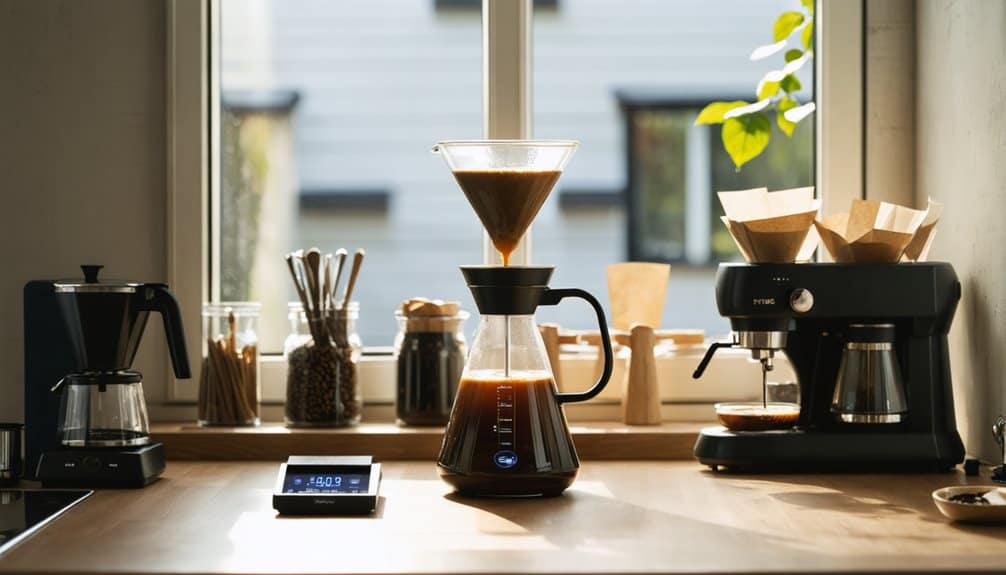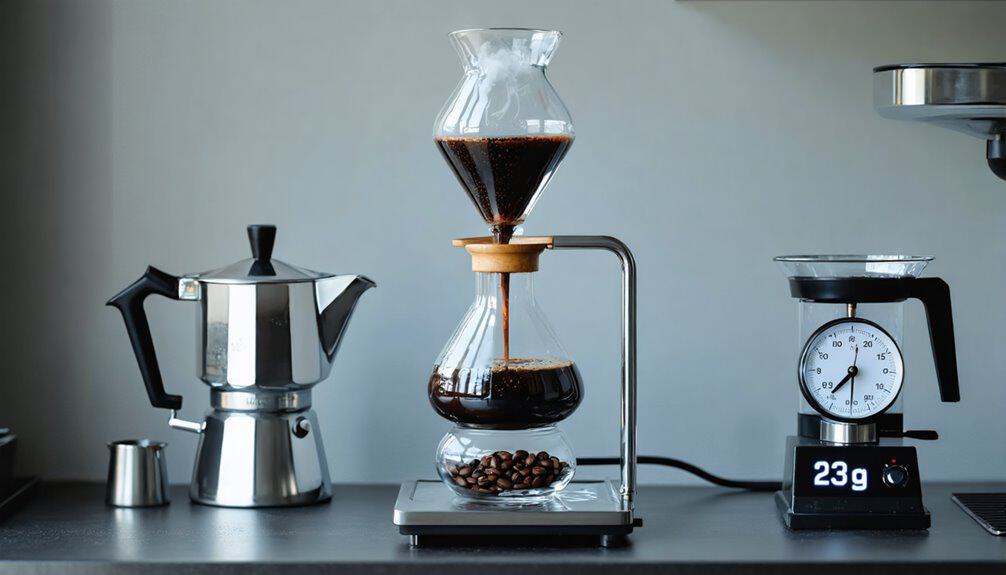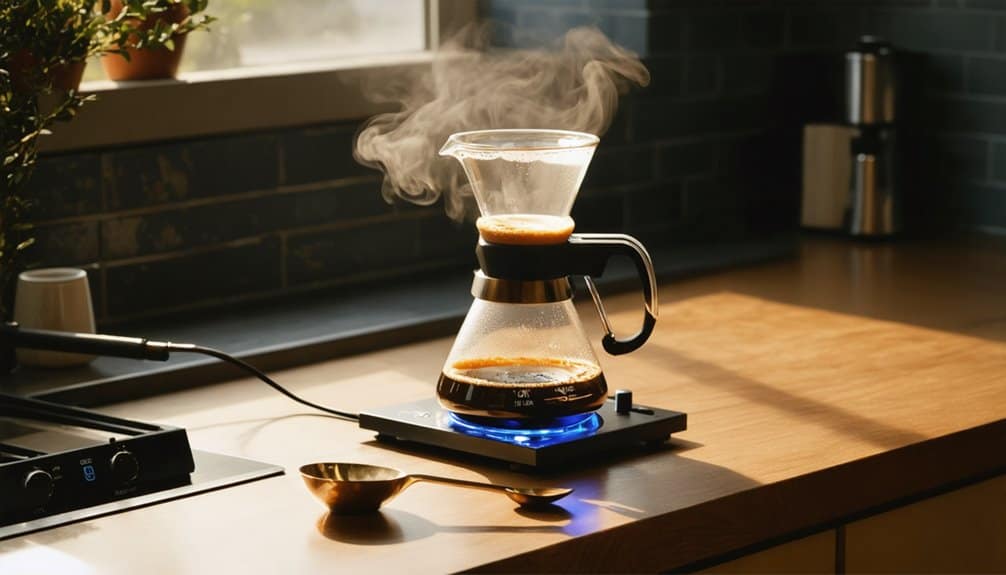To brew with a siphon, start by preheating your water to 90°C and setting up your pre-soaked filter in the upper chamber.
Add 300g of water to the bottom chamber and position it over your heat source. Once the water rises to the top chamber, add 23g of medium-coarse ground coffee (1:15 ratio).
Stir gently and maintain the temperature at 92°C for ideal extraction.
After 2 minutes, remove from heat and watch as gravity pulls the brewed coffee back through the filter.
Master these fundamentals, and you’ll reveal the full potential of vacuum brewing’s theatrical chemistry.
Key Takeaways
- Heat 300g of water in the lower chamber to 94°C, ensuring proper seal between chambers for optimal vacuum pressure.
- Set up the pre-soaked filter in upper chamber and wait for water to rise through the connecting tube.
- Add 23g of medium-coarse ground coffee once water fills upper chamber, stirring gently to ensure even saturation.
- Maintain temperature at 92°C for exactly 2 minutes while coffee brews in the upper chamber.
- Remove heat source and watch coffee drain back through filter into lower chamber for a clean, flavorful brew.
Essential Equipment and Setup

Anyone can make exceptional siphon coffee with the right equipment and proper setup.
You’ll need a siphon coffee maker with two chambers connected by a tube, a reliable heat source like an alcohol burner or gas stove, and fresh coffee beans.
Don’t forget your digital scale for precise measurements and a quality grinder for consistent results.
To achieve optimal extraction, aim for a medium-coarse grind size.
Before brewing, you’ll want to attach the filter securely to the top chamber and add preheated water (90°C/195°F) to the bottom vessel.
Position the top chamber at an angle into the bottom one, ensuring the entire setup is stable on its stand.
You’ll also need a digital thermometer to monitor temperature, a timer for precision, and a stirring utensil.
Remember to use filtered water and keep a bamboo paddle nearby for managing the coffee grounds.
Preparing Your Siphon Brewer
Begin by soaking and positioning your filter in the upper chamber, confirming it’s perfectly centered.
Next, heat your water to exactly 94°C while assembling the chambers with a proper seal. This elegant double glass body design has been perfected since the 1830s.
Once assembled, fill the lower chamber with 300g of hot water and position the setup over your heat source. You’re now ready to start the brewing process.
| Step | Action |
|---|---|
| Filter Prep | Soak filter, center in upper chamber, secure chain |
| Water Setup | Heat water to 94°C, measure 300g for standard brew |
| Assembly | Connect chambers with proper gasket seal, guarantee stability |
| Heat Control | Position over heat source, maintain 185-195°F |
The Perfect Coffee Ratio

Finding the perfect coffee-to-water ratio is crucial for achieving ideal flavor extraction in siphon brewing.
You’ll want to start with the standard ratio of 7 grams of coffee per 100ml of water, or follow the proven 35g coffee to 560ml water measurement for a standard setup.
If you’re working with well-developed roasts, consider trying a 1:17 or 1:18 ratio for higher extraction yields.
Your grind size should match your chosen ratio. Use a medium-coarse grind similar to beach sand for standard brewing, or go finer than espresso for high-extraction methods.
This theatrical brewing process has captivated coffee enthusiasts since its revival in modern coffee culture.
To guarantee maximum results, you’ll need to maintain water temperature at 93°C while brewing, and remember to fill at least 2/3 of your siphon’s capacity for proper vacuum during drawdown.
Mastering The Heating Process
Heat control mastery stands as the cornerstone of successful siphon brewing.
You’ll want to begin by heating your bottom chamber until it reaches boiling point, ideally using preheated water at 90°C (195°F) to accelerate the process.
Fill the chamber to just above the “2” mark if you’re using a Hario TCA-2.
Once the water rises to the top chamber, reduce your heat source to its lowest setting while maintaining the water’s position.
You’ll need to stabilize the temperature at 92°C (198°F). A thermometer’s your best friend here – use it to monitor and adjust accordingly.
This precise timing will ensure the ideal brew time of 2 minutes for optimal coffee extraction.
For best control, consider using a butane burner instead of traditional alcohol burners.
Remember, you’re aiming for consistent temperature throughout the brewing cycle, as this directly impacts your extraction quality.
Expert Brewing Techniques

Through precise measurements and technique, expert siphon brewing begins with the critical ratio of 1:15 coffee to water.
You’ll need 23 grams of coffee for every 300 grams of water, ensuring your medium-coarse grounds are freshly roasted for ideal flavor.
This immersion brewing method delivers exceptional body and clarity compared to other techniques.
| Action | Technique |
|---|---|
| Filter Prep | Pre-soak in hot water |
| Water Temp | Heat to 94°C |
| Coffee Inclusion | Add after water rises |
| Stirring | Gentle, minimal motion |
| Heat Removal | After 1-2 minutes |
After assembling your siphon with a tight seal, you’ll want to secure the pre-soaked filter by hooking the chain to the glass tube.
Remember to maintain precise temperature control using your butane or alcohol burner.
As you progress, you’ll develop an instinct for the perfect extraction, adjusting your technique based on taste and avoiding over-extraction through minimal stirring.
FAQs
Why Does My Siphon Coffee Sometimes Taste Bitter or Burnt?
Your siphon coffee’s bitter taste likely stems from over-extraction due to water that’s too hot, grinding too fine, or brewing too long. You’ll need to adjust these variables for better results.
Can I Use Pre-Ground Coffee in a Siphon Brewer?
While you can use pre-ground coffee, it’s not ideal for your siphon brewer. You’ll get better results by grinding fresh beans to a medium-coarse consistency just before brewing.
How Long Should My Siphon Coffee Maker Typically Last?
Like a well-tended garden, your siphon coffee maker should thrive for 5-10 years. You’ll get the best longevity through regular descaling, proper cleaning, and using filtered water.
What Causes the Vacuum Effect to Fail During Brewing?
Your vacuum effect can fail from blocked filters, incorrect brewing temperatures, poor seals letting in air, or inadequate heat causing incomplete steam expansion and condensation during the process.
Why Does Coffee Sometimes Flow Back Into the Upper Chamber?
You’ll experience coffee flowing back when there’s improper heat management, damaged seals, or incorrect chamber assembly. These issues disrupt the vacuum process and prevent proper negative pressure formation.
The Bottom Line
You’ve now mastered the intricate art of siphon brewing, a method that’ll produce coffee so phenomenally clean it’s practically laboratory-grade.
By precisely controlling temperature, grind size, and immersion time, you’ll create a cup that’s light-years ahead of standard brewing methods.
Remember to maintain your equipment meticulously – even a microscopic variation in cleanliness can affect your results.
Your dedication to this exacting process will consistently yield extraordinarily pure coffee.